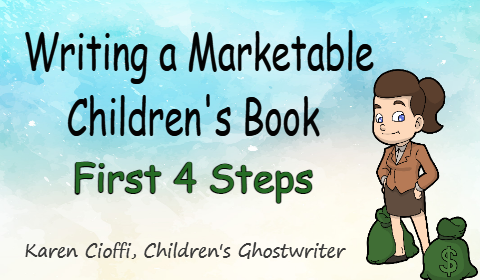No matter how you look at it, writing books is a business. The same goes for writing magazine articles, copywriting, and so on.
Any time you write with the thought of selling what you’re writing, it becomes a business.
It’s not that the marketing end of your writing should put a damper on your muse, but there are a few key marketing components that you need to keep in mind when writing.
- The very first component is your audience.
It’s been said over and over that you need to have a target market – a target audience for your book.
If you think about it, you’ll realize that’s true.
Imagine you wrote a story about your Alaskan adventure.
Who do you think would be interested in it? Who do you think would buy your book?
Now, imagine you wrote a children’s middle-grade fantasy.
Same questions.
But the answers will be different.
In an article at Live, Write, Thrive, the author takes this a step further. She advises to analyze your ‘perfect’ reader. Find out what he likes. Does he have any pets? Does she like sports, music, or art? What’s her family life like? What about school? What about friends? The deeper you go, the better.
You can craft a story geared toward that reader with the answers to these questions. Or you can include tidbits that particular reader can relate to in a story you are already writing.
Maybe your reader is a junior lifeguard and cross-country runner. And he has an eighty-pound, bronco-jumping Bernedoodle.
With this knowledge, you can craft a story that incorporates elements related to the readers’ age group without taking away from the story’s creative process.
- Have a great theme.
First, what is theme?
One explanation of theme is from MasterClass: “In simpler stories, the theme may be a moral or message: ‘Don’t judge a book by its cover.’ In more complex stories, the central theme is typically a more open-ended exploration of some fundamental aspect of society or humanity.”
The theme should be subtly woven into your story.
But there are occasions when you don’t know what the theme of your story is until it’s complete.
Six of the most common themes are:
-Good vs. evil
-Love
-Redemption
-Courage
-Coming of age
-Revenge
As a children’s ghostwriter, the themes I see most often from clients are:
-Be who you are
-Acceptance
-Being a good friend and making friends
-Kindness
-Bullying
-Environment
For a children’s writer or someone who wants to be the author of their own children’s book, the themes tend to be geared toward bringing awareness to children. The themes are usually about teaching children, guiding them.
Your theme should be like a ghost, invisible. But like the wind, you can feel it. You know it’s there.
- Be different.
It’s challenging to come up with a unique story. Everything that can go on in life has been written about.
So, how do you keep your story fresh?
A good way to do this is to study recently published books in your genre. Make the bulk of them traditionally published, as they would have had to get past the gatekeepers.
There are two reasons for researching traditionally published books:
A. As mentioned, the storyline and writing will be good…good enough to make it past the gatekeepers.
B. Publishing houses know what’s being received well and what’s not. They’re doing a lot of research that you can take advantage of.
After you research your contenders, buckle down and write a better story, one that has a different spin. This may take a great deal of effort, but it will help make your story stand out; it will make your story unique.
Want to stay away from popular stuff? Think about historical fiction.
If you go this route, keep in mind you need an audience that will be interested in it.
You might even get ideas from folktales. Not the ‘overly done’ ones, but older, ancient tales.
Whatever you write, make it your own.
- Write a good story.
You can take all the steps necessary to create a marketable children’s book, but if the story isn’t properly written, if you don’t have a good story, those steps will be for naught.
Here is a quick breakdown of the elements needed to write a good story:
-Theme (we discussed this already)
-Plot
-Story structure
-Characters
-Setting
-Style and tone
To learn what’s involved in each of these elements, you can check out:
6 Tips on What Makes a Good Story?
https://karencioffiwritingforchildren.com/2017/06/18/what-makes-a-good-story-6-tips/
I’m a working children’s ghostwriter, rewriter, and coach. I can help turn your story into a book you’ll be proud to be the author of, one that’s publishable and marketable.
OTHER HELP I OFFER:
HOW TO WRITE A CHILDREN'S FICTION BOOK
A DIY book to help you write your own children’s book.
FICTION WRITING FOR CHILDREN eCOURSE
4-Weeks / 8 Sections Guided Self-Study Mentoring Program
WRITERS ON THE MOVE SELF-PUBLISHING SERVICE
Self-publishing help for children’s authors
(Picture books and chapter books)
You can contact me at: kcioffiventrice@gmail.com.


